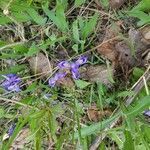Rhizomes with proximal cordlike portion 0.8–2 dm × 2 mm, bearing brown, scalelike leaves and rarely roots, distal portion enlarging to 3–5 × 0.8–1.2 cm, producing fibrous roots, 2–3 brown, sheathing, bractlike leaves, then 8–12 green foliage leaves; usually 2 cordlike rhizomes produced from apex as new growth begins in spring. Stems simple, 0.8–4 cm. Leaves: basal with blade broadly linear at anthesis, slightly falcate, 4–6 cm × 6–8 mm, enlarging to 16 cm × 10 mm; cauline with proximal 1–2 resembling basal leaves, 4–6 cm, distal 2 more sheathing of stem, exceeding spathes. Inflorescence units 1(–2)-flowered; spathes green, outer closely sheathing inner and enclosing ovary, slightly keeled at midrib, 4.5 cm, ± equal, margins scarious. Flowers: perianth sky blue; floral tube dull yellow, funnelform, 1–2 cm, dilated upward to 4–5 mm diam.; sepals 2–2.3 × 0.8 cm, tapering gradually into claw, apex emarginate, signal white with deep violet margin, with 3 yellow and white, toothed, low ridges; petals spreading, narrowly oblanceolate, 1–1.5 × 0.4–0.5 cm, shorter and narrower than sepals, apex emarginate; ovary sharply trigonal, 0.8–1 cm; style 1–2 cm, crests linear to semiovate, 4 mm, margins crenate; stigmas rounded, margins entire; pedicel 0.6–1.5 cm. Capsules roundly triangular, 1.2 × 8 mm, enclosed in spathes. Seeds dark brown, with white appendage spiraled around seed, ca. 3 mm, quickly drying when exposed to air. 2n = 32, 42.
More
Like a smaller form of no. 2 [Iris cristata Aiton]; lvs broadly linear, curved-arching, 4–6 cm at anthesis, later to 18 cm × 5–10 mm; spathe-valves closely sheathing each other, the upper and lower equally spaced; perianth-tube dull yellow, 1–2 cm, dilated upwards, not or scarcely exceeding the spathe-valves and shorter than the sep and pet; fls 5–6 cm wide, the pet emarginate; seeds dark brown, arillate; 2n=42. Gravelly shores and cliffs in calcareous soil around lakes Michigan and Huron; now rare. May.


